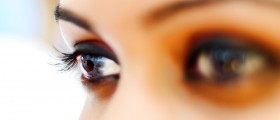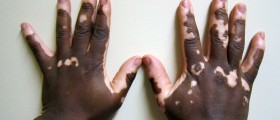
Albinism is a congenital type of disorder which can easilybe described by partial or complete absence of pigment in the eyes, the hair orthe skin. Albinism occurs mainly due to absence or defects of a certain type ofenzyme which is responsible for the production of melanin. This medicalcondition got its name from the Latin word albus, which translates to white.Albinism is inherited by means of recessive gene alleles. People who are characterizedby a complete absence of melanin are referred to as albinos, while those whoonly have a diminished amount of melanin are referred to as albinoids. The biggestproblem with albinism is that it may be associated with astigmatism, nystagmus,photophobia, vision defects and increased risk of sunburn and skin cancers.
No Pigment in the Skin
There are two different types of albinism which may occur inhuman and those are oculocutaneous albinism and ocular albinism. Ocularalbinism affects only the eyes, and it does not affect the skin and hair,although in some cases their color may be a bit lighter than those of theperson’s parents. It is an interesting fact that ocular albinism affects malepersons much more than it affects women. Oculocutaneous albinism involvesdifferent levels of pigmentation which may affect the hair, the skin and theeyes. Different ranges of severity may involve having no pigment at all toalmost normal levels of rather pale skin. There are also several other types ofmedical conditions which may involve albinism as a part of their presentation.Such medical conditions include the Tietz syndrome, the Waardenburn syndrome,the Griscelli syndrome, the Chediak-Higashi syndrome and the Hermansky-Pudlaksyndrome. Some of them can be easily distinguished by visual appearance whilesome others can only be diagnosed by certain types of genetic tests.
Causes of Albinism
Albinism can be passed on from person to person, thecondition can only be inherited. The genes actually play the main role in thedevelopment of albinism. Thousands of genes are contained in each chromosome,and they are in charge of providing the person with all different types ofphysical traits and various other parameters. They also instruct all the bodyparts how to function properly. Each person is actually individual only thanksto the information contained in the genes which determine the color of one’seyes and the type of hair, among other things. Each person has two sets ofgenes. One set is obtained from the mother, and the other from the father. Eachparent of a person has a normal pigment gene but also an albinism gene.Albinism occurs in a person only in case when the albinism genes from bothmother and father get passed on to the child.
Signs and symptoms of Albinism
Albinism in humans is characterized by either white or verypale appearance due to the absence or lack of melanin which is responsible fornormal coloration of the skin, hair and the eyes. Persons who have albinism areat an increased risk of burning their skin by the harmful ultraviolet rays dueto the partial or complete absence of melanin from the skin. When it comes tonormal anatomy of the eyes, the pigment is in charge of providing the color tothe iris and lending proper opacity to the eye. The eyes of those who havealbinism may appear purple or red, mainly due to the lack of pigment in theeyes. Other characteristic signs of albinism may include problems with vision.Most albinistic persons are characterized by normal health, growth anddevelopment as albinism is not involved with any increased rate of mortality.Melanin is an important factor in proper development of the optical system sowhen it is present in lower amounts or no amounts at all it may lead to certaintypes of visual problems. Amblyopia is characterized by a decreased acuitytriggered by poor transmission to the brain. Astigmatism, hyperopia, myopia andother types of refractive errors may also occur due to albinism. Another commonmedical condition induced by albinism is called optic nerve hypoplasia. Thismedical condition can easily be identified as improper or insufficientdevelopment of the optic nerve. Another eye condition which may often betriggered by albinism is nystagmus. This medical condition involves rapid,irregular movements of the eye, whether in a circular pattern or back andforth. Reduced visual acuity may occur due to light induced retinal damage orperhaps another medical condition called foveal hypoplasia. Photophobia mayoften be related to albinism, and in most cases it is induced by lightscattering within the eye and it often can be accompanied by decreased visualacuity.
Life with Albinism Disorder
Those who have albinism are actually normal people just likeanybody else. They just need to be a little extra careful when it comes tospending extended periods of time in the sun.

















Your thoughts on this
Loading...